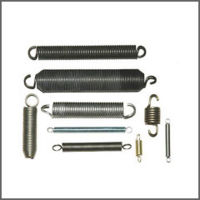Difference between revisions of "Rotational Stiffness"
EricNickel (talk | contribs) |
EricNickel (talk | contribs) |
||
| Line 21: | Line 21: | ||
==Linear Spring== |
==Linear Spring== |
||
[[Image:extensionsprings.jpg|thumb|200px|Extension springs avaiable through Ganga Spring Industries|right]] |
|||
A linear extension spring is generally a coil, usually made of a tempered steel. The thickness of the wire used to make the spring and the number and diameter of the coils determines the stiffness. |
A linear extension spring is generally a coil, usually made of a tempered steel. The thickness of the wire used to make the spring and the number and diameter of the coils determines the stiffness. |
||
Revision as of 19:03, 20 March 2008
Stiffness
Stiffness (k) is the relationship between an applied force and the displacement the force produces. This relationship can be defined for two common cases:
In the linear case, the applied force (F) is proportional to the linear displacement (x) of one end of the "spring" with respect to the other (i.e. the amount of stretch or compression of the spring).
F = k * x
In the rotational case, the applied torque (T) is proportional to the angular displacement (theta) of one side/end with respect to the other.
T = k * theta
In both cases, the relationship can be non-linear, however a linear relationship is easier to work with.
Linear Spring
A linear extension spring is generally a coil, usually made of a tempered steel. The thickness of the wire used to make the spring and the number and diameter of the coils determines the stiffness.
Torque/Moment
Vector Decomposition
Programmable Stiffness Joint
Static Insertion
Rotating Insertion
Spring Extension
Torque
Rotational Stiffness
